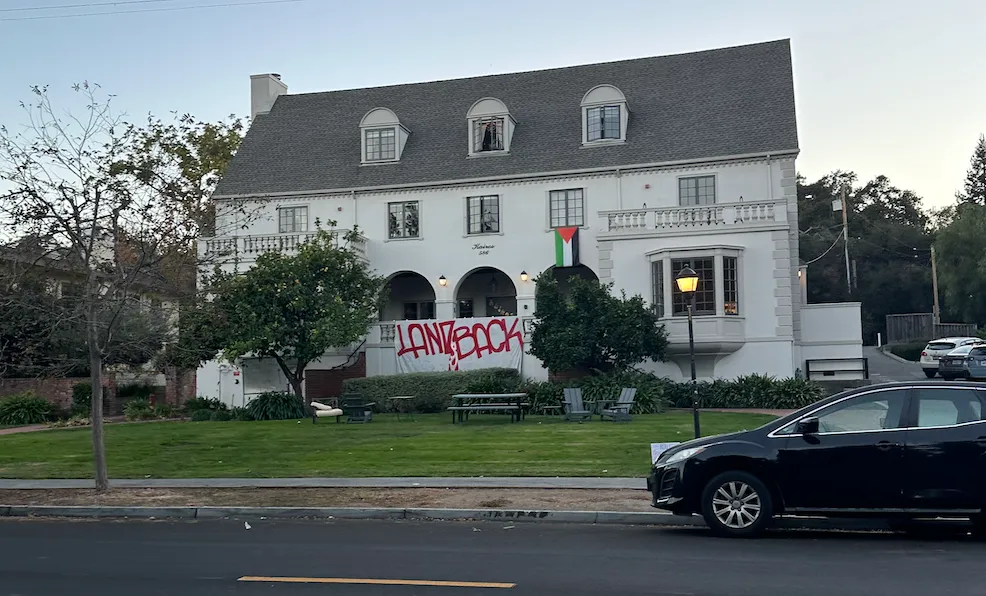Table of Contents
At the start of this year, Stanford debuted a new website to compile campus guidelines on free speech and academic freedom in one place. There is much to commend about the policies clarified on the website, which generally fall within the following categories:
- Requiring advance registration for demonstrations.
- Prohibiting the disruption of University events.
- Ending overnight camping.
- Restricting non-water-soluble sidewalk chalk.
- Limiting where posters and chalk drawings can be displayed throughout campus.
But then there is the policy prohibiting flags from hanging outside dorm windows, which is unlike these others in a crucial way: by its very language, the regulation contains a highly ambiguous, content-based exception to its edict. Accordingly, Provost Martinez’s office should re-evaluate the flag policy to be more consistent with the exact free speech values the University claims to uphold.
Stanford’s Statement on Freedom of Expression clarifies that University restrictions on speech based on its content jeopardize the free inquiry that institutions of higher learning are designed to promote. However, it is not only the University’s mission that guides its treatment of free speech. Under California’s Leonard Law, even private universities like Stanford must abide by the same Constitutional principles as public ones—state actors—when crafting speech policies. Although schools occasionally have some broader latitude in the First Amendment context, students at the university level generally enjoy the same free speech rights on campus as they would beyond it. And under First Amendment doctrine, “content-based” regulations on speech are generally unconstitutional.
Stanford’s ban on hanging flags outside dorm windows is so ambiguous that it naturally raises questions about the University’s commitment to these free speech principles. As the policy dictates, “With the exception of banners that have been approved consistent with a residential theme, exterior banners, flags or other objects may not be placed on, or hang on or over the exterior of any building, outside of any window, or on or over any balcony railing.” The chief problem then arises: the policy makes vague use of the passive voice, making it unclear who is to determine what a residential theme consists of. Especially on the Row or within Co-op style housing where there is far less structure to residential hierarchies, this policy can lead to subjective and arbitrary decision-making. The following hypotheticals make clear just how unclear this policy truly is:
- Could students in Otero—Stanford’s Public Service and Civic Engagement Theme House—fly a banner encouraging a “Get out the vote” effort?
- What about students in Trancos—Stanford’s Outdoor House? Could they hang a banner pleading to “Save our environment”?
- Or could the Enchanted Broccoli Forest, given its stated commitment to “empowering BIPOC, gender-marginalized, queer, and FLI voices” incorporate a Pride flag into their residential banner?
Regardless of the specific speech at issue, the ambiguity in the policy necessarily deters expression. Additionally, given that Stanford’s theme housing, Co-ops specifically, disproportionately skews toward more liberal viewpoints, this policy sets a dangerous precedent of allowing unnamed officials to determine the realm of permitted speech while stifling disfavored voices, as speech will necessarily be subjected to qualitative judgments on whether it is “consistent with residential themes.”
Even though the website asserts that this policy is nothing new, the recent crackdown certainly is. Across campus, R&DE (the organization that controls Stanford’s Housing and Dining) has restricted the display of any national flag outside dorm windows, including that of the United States. While Stanford bans this simple display of patriotism, the policy’s exception leaves room for R&DE officials to approve other messages under the guise of residential themes. Is it really the University’s position that patriotism toward the United States—the nation that houses Stanford—is inconsistent with the “theme” of any community on the campus of a university that owes a large share of its research funding, subsidies, and other privileges to this country’s taxpayers?
How well does that square with the history that Stanford prides itself on of being the first truly modern great American university, unlike its Ivy League equivalents that were founded during colonial times? A comparison to Co-op housing illustrates the disconnect embedded within the policy in its current form: could students in Hammarskjöld, Stanford’s “International Understanding” Co-op, display a banner that celebrated all the different flags from each residential member’s home country?
As the above examples demonstrate, the current rule involves a content-based determination about what is consistent with whatever “theme” a given residential community has. The reality of how housing works on campus only compounds this challenge to Stanford’s promise of neutral free speech regulations. Since many of Stanford’s housing options embrace “social justice”-related interests, broadly defined as part of their residential theme, the implementation of the flag policy in its current form risks further stifling the comparative presence of more traditional speech on campus—that which lacks a home within any of the University’s pre-determined theme housing options.
Provost Martinez is undeniably one of her generation's most brilliant legal minds, one who the Stanford community is lucky to have. However, her constitutional advocacy background makes the flag policy’s holes and unanswered questions all the more perplexing. The hypotheticals raised in this piece are not simply theoretical thought experiments: they get at the heart of exactly what any durable free speech policy requires—and what the flag policy lacks—consistency and clarity.
Until then, even as officials have asked for American flags to be taken down from windows throughout campus, Palestinian flags remain hanging outside of residences on the Row. There is either a problem with the policy, its enforcement, or perhaps both, that administrators have a responsibility to re-evaluate. Given the importance of promoting open discourse on campus, especially given the events of the past year, the administration owes its student body answers on this issue.





